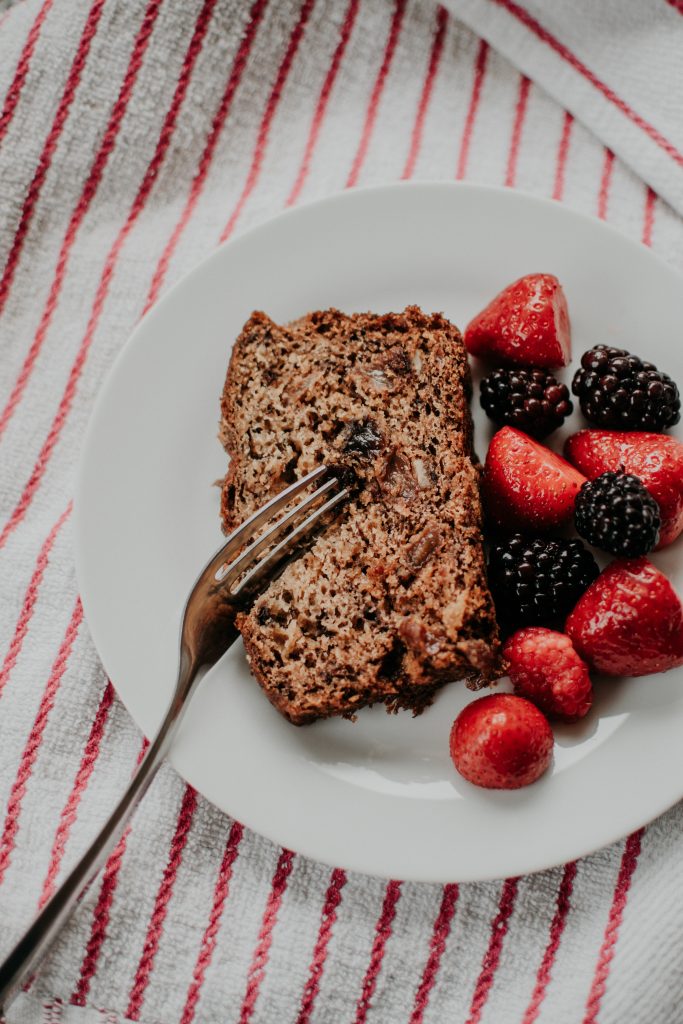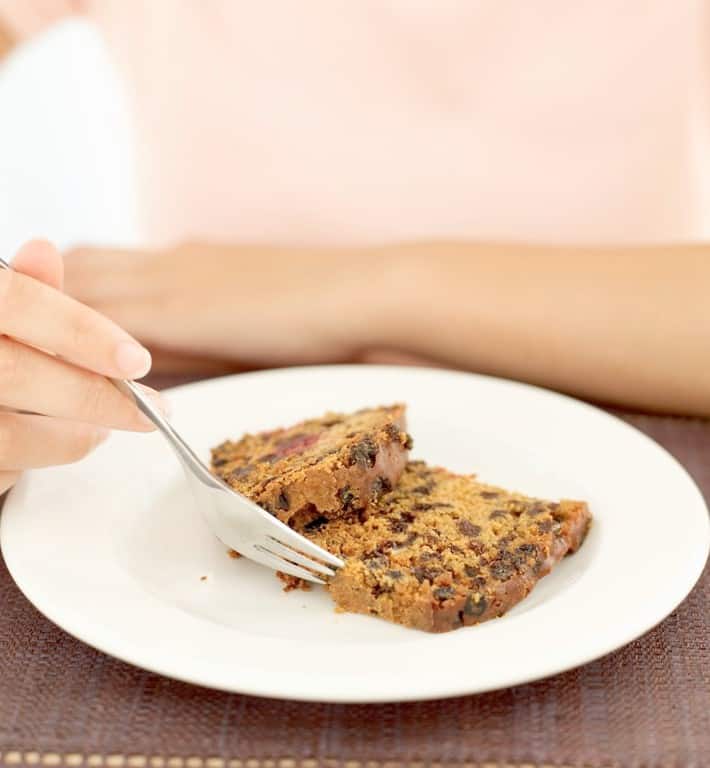As an Amazon Associate we earn from qualifying purchases.
When you think “fruitcake,” you think of a dense loaf of bread dotted with red and green glacé cherries.
Sometimes the loaf has rum or other alcohol in it. It’s typically dry, and the mock-up cherries do little to give it flavor. No wonder the tough loaf is often considered the holiday punchline.
But that’s not how authentic fruitcake tastes.
What Does Fruitcake Taste Like?
The fruitcake at the convenience store is a terrible rendition of what it is supposed to taste like. So, what does fruitcake taste like?

Good, homemade fruitcake is dense but never dry and tough. It is rich in spice and has a lovely portion of nuts and preserved fruits in it. It is often soaked in liquor – typically rum – for a while before it is served.
What Authentic Fruitcake Tastes Like
But then why does most fruitcake you find in stores and also online taste dry and have fluorescent-looking candy in it?
Looking into the definition and history of fruitcake can provide the insight I need.
Making Sense Of The Many Variations Of Fruitcake
The truth of the matter is that the definition of a “fruitcake” isn’t nuanced. It is meant to be a bread base with dried (or candied) nuts and fruits. Also, an authentic fruitcake must have alcohol in it.
Besides that, a fruitcake can have all kinds of spices in it. There’s no set shape associated with a fruitcake, either. It can be a long log or prepared in a bundt pan – the shape is of no relevance.
Because the dessert is so loosely defined, different cultures have different variations of it. The German Christmas Stollen and the Italian Panettone are, at their crux, fruitcakes.
The concept of fruitcakes was first introduced to America in the 16th century. Fruitcakes didn’t become the hard pieces of disregarded bread until 1913, when mail-order fruitcake made gifting easier in the holidays.
Why Fruitcake Gets A Bad Rap
Hundreds of years ago, in the backdrop of poverty, celebrating the holidays with fruitcake would be considered a sign of wealth. Back in the day, fruits, especially those only available in warm climates, were hard to come by when it got colder.
Using oranges and lemons in the cake and celebrating the holidays was a way to show that one could afford those ingredients. The only way to get those fruits was dried or candied – which is why they’re used in fruitcake to this day.

Liquor was added to the cake after baking to make it even more exquisite.
A few decades later, eating fruitcakes with citrus fruits during the holidays was no longer expensive since those ingredients got cheaper and were available year-round.
Why Modern Store-Bought Fruitcake Tastes Bad
Companies attempt to recreate the taste of traditional fruitcake with cherry candy and liquor flavoring – making it taste a lot worse than it’s supposed to. The candied ingredients added make the cake look like it has pockmarks, making it less appetizing.
Furthermore, the fruitcake is aged before it is packaged and sold, making it cruelly dry and tougher than it should be.
Very few companies take a chance with their products and add flavors that haven’t been available for centuries, like chocolate and vanilla, to the cake.
The first fruitcake you ate was likely bought at a convenience store, and for reasons mentioned above, you didn’t like it. Making it yourself can take time and effort, but the delectable result is worth the effort.
The Experts Take On What Fruitcake Should Taste Like
In her interview with Thrillist, author and fruitcake historian Virginia Glass agrees that the mass-produced fruitcakes taste nothing like authentic fruitcake.
True fruitcake is moist and has a little sponginess to it – it is never tough or dry and crusty. Fruitcake tastes like a mix of dried fruit and alcohol, with an elegant hit of spice.
Virginia thinks the glacé cherries are what went wrong with mass-produced fruitcake since it has no resemblance to real fruit at all.
Making A Homemade Fruitcake
Here’s how Virginia goes about making her fruitcake:
Besides using some golden raisins, dried Michigan cherries, dried apricots, honey, and dark brown sugar, she adds some single-barrel Scotch, candied orange peels, and a touch of salt. She never uses figs or dates.

The cake comes out moist and delicious, and the contrast in the taste is significant compared with store-bought fruitcake.
Frequently Asked Questions
Why Does Fruit Cake Last So Long?
Fruitcake lasts very, very long – researchers found a 100-year-old fruitcake in an edible condition quite recently. The preserved ingredients used, the density of the loaf, and the alcohol make it last longer.
How Do You Feed A Fruitcake?
“Feeding” a fruitcake means soaking the cake in alcohol to make it moist and give it more flavor. To feed a fruitcake, place it on parchment paper, and poke holes on the top of the cake no deeper than halfway through the cake.
Next, pour 2-3 tablespoons of your alcohol of choice into it before wrapping it with parchment paper. Feed the cake every week until Christmas day.
How Do You Eat A Fruitcake?
Besides eating fruitcake as it is, you can try toasting a slice of it until it gets a little crunchy. Buttering the toasted slice or pairing it with a sharp cheddar is a great way to enjoy it.
You could also crumble the cake over ice cream and enjoy it that way.
What Goes Well With Fruitcake?
Having an aperitif is an excellent idea before eating fruitcake. Red wine and champagne go best with a rich and moist fruitcake.
Conclusion
The key to eating fruitcake that tastes good is to make it yourself. When you soak the fruit for a few days before using them and ensure that the fruit doesn’t suck up all the moisture from the bread, the resulting cake comes out tasting great.
Bear in mind that making a fruitcake can take weeks since you have to feed it at regular intervals after you bake it.
But now that you know how good fruitcake can taste, though, giving making one a shot won’t sound like a bad idea.
